
The first question one might ask is what makes a star cluster super-sized? And the answer is easy – star clusters that are relatively close to us appear larger in the sky.
The first of these three clusters is arguably the best known star cluster of all. It is the Pleiades, aka the Seven Sisters, aka Messier 45, aka any number of additional names, recognized and watched for thousands of years based on prehistoric artifacts.
If you already know the second of our three clusters, odds are you have some experience with astronomy. The second super-sized cluster is the Hyades, officially cataloged as Melotte 25. Not as widely recognized as the Pleiades, it is significantly larger in apparent size because it is closer to us, about 153 light years distant compared to about 440 light years for the Pleiades.
Even experienced observers might be scratching their heads about our third cluster, because it is somewhat obscure, though easily seen. Kudos if you already knew its identity – Collinder 65. It is mostly in Taurus, though a portion of it extends into nearby Orion.
Here are some basic astrophysical parameters for the clusters, which involved more research than I had anticipated. What led me down this astro-rabbit-hole was trying to come up with basic facts for Collinder 65, which is mentioned on numerous web pages with rudimentary information about how to find it in the sky, but no details about its distance, size, etc. frankly because the cluster is obscure enough that one must turn to professional journals for detailed information, which are somewhat opaque for the non-scientist. (At least for this non-scientist.) The adventure has increased my familiarity with VizieR, simbad, and the CDS Portal, of which more to come in future posts.
Pleiades
Apparent size: 1.83 degrees (110 arc-minutes)
Distance: 440.31 light years J/MNRAS/504/356
Size: 7 light years J/MNRAS/473/849
Number of stars: 847 J/MNRAS/504/356
Age: 110-160 million years AstroPhysical Journal vol 863 num 1
Hyades
Apparent size: 5.5 degrees (330 arc-minutes)
Distance: 153.29 light years J/MNRAS/504/356
Size: 10 light years Wikipedia
Number of stars: 462 J/MNRAS/504/356
Age: 680 million years AstroPhysical Journal vol 863 num 1
Collinder 65
Apparent size: 3.66 degrees (220 arc-minutes)
Distance: 1060 light years J/MNRAS/473/849 (Dib S.)
Size: 21.98 light years J/MNRAS/473/849 (Dib S.)
Number of stars: 1,425 J/MNRAS/473/849 (Dib S.)
Age: ??
The Hyades appears almost exactly three times larger to us than the Pleiades mostly because it is nearly three times closer. (It is about 30% larger). Collinder 65, while twice the actual size of the Hyades, appears smaller because it is nearly 2.5 times more distant. The Hyades is sometimes said to be the closest open cluster to us, but others describe it with some justification as the second closest open cluster. Odds are you have seen members of the closest open cluster, but perhaps without realizing they are part of a cluster at all. Many of the bright stars forming the Big Dipper are part of the Ursa Major moving group, an open cluster our sun drifted into about 40 million years ago. So we are actually inside it. We’ll save the rest of that for another post. The Hyades is certainly one of the most studied open clusters. Literally thousands of scientific papers have been published about it — the simbad bibliographic survey lists 2,927 papers that reference the Hyades published between 1850 and 2023.
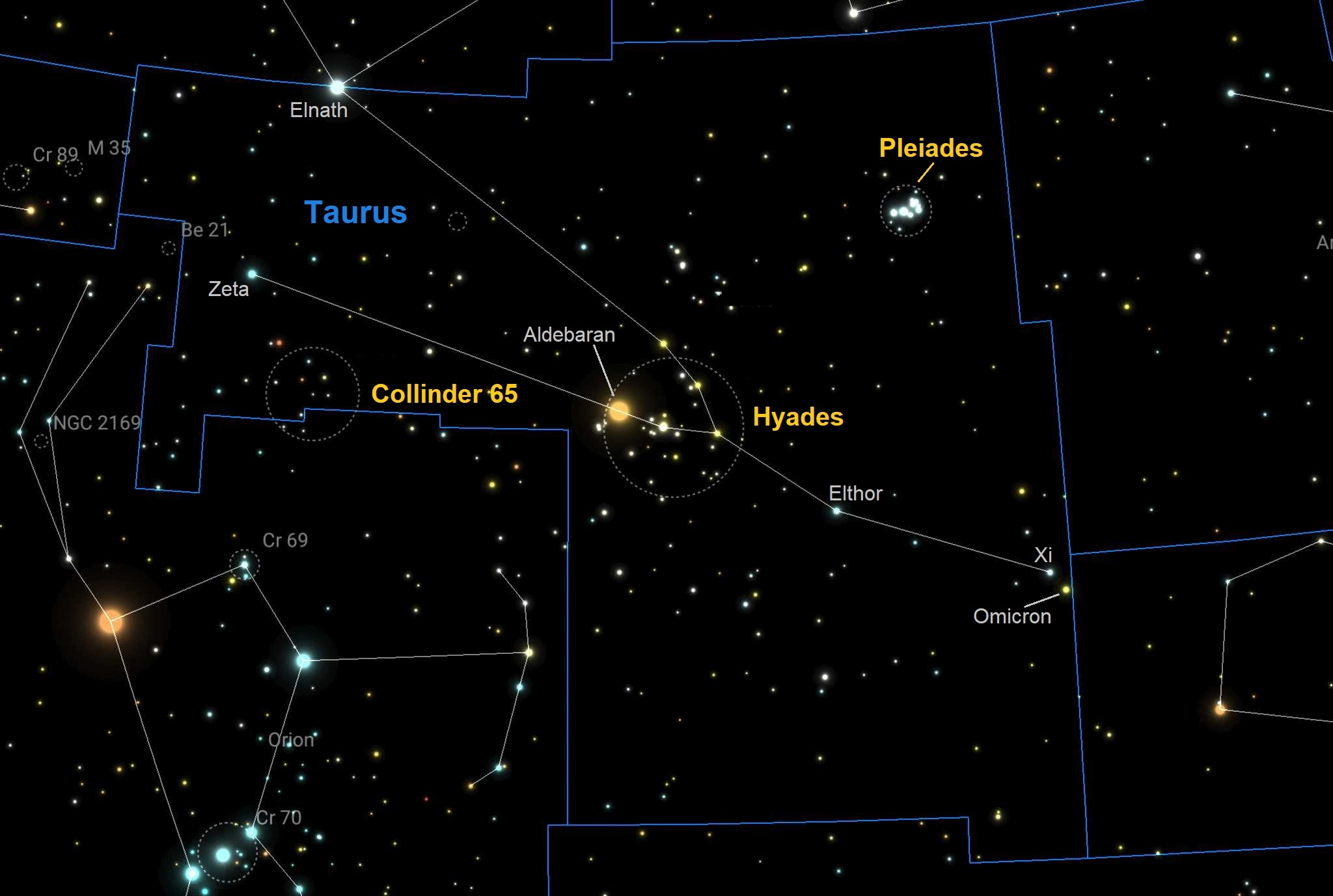
When you step outside with binoculars to view these clusters, hopefully with a camp chair or a zero-gravity chair for comfortable observing, take some time to look at the sky without optical aid. The Pleiades is easy to spot as a small, bright group of stars. Nothing else in the sky is like it. If Orion is above the horizon, you will find the Hyades about one third of the way from the Pleiades to the three bright stars of Orion’s belt. If you are fortunate to have darker skies, the “V” of the Hyades will be easily seen. Even from my light polluted, suburban skies, I can see enough stars recognize it. Without binoculars I see only a couple stars near the position of Collinder 65 from my yard, in averted vision, one being the 4.36 magnitude red supergiant star 119 Tauri, adjacent to the cluster. The other, somewhat farther off, is 3.0 magnitude Zeta Tauri (labeled in the chart above), marking the tip of Taurus’s southern horn.
Before taking a closer look at the clusters, see if you can pick out the brightest stars in Taurus, labeled in the chart above. The star which marks the northern horn tip is shared with the constellation Auriga, positioned as it is on the boundary between the two. It is easy to suppose that the main part of Taurus is outlined by the V-shaped head and the horns, which extend to the northeast. But, in reality, this is only a small part of the constellation. Picking out Elthor and then Xi and Omicron Tauri to the west helps one understand the vast size of this constellation, the 17th largest in the sky.
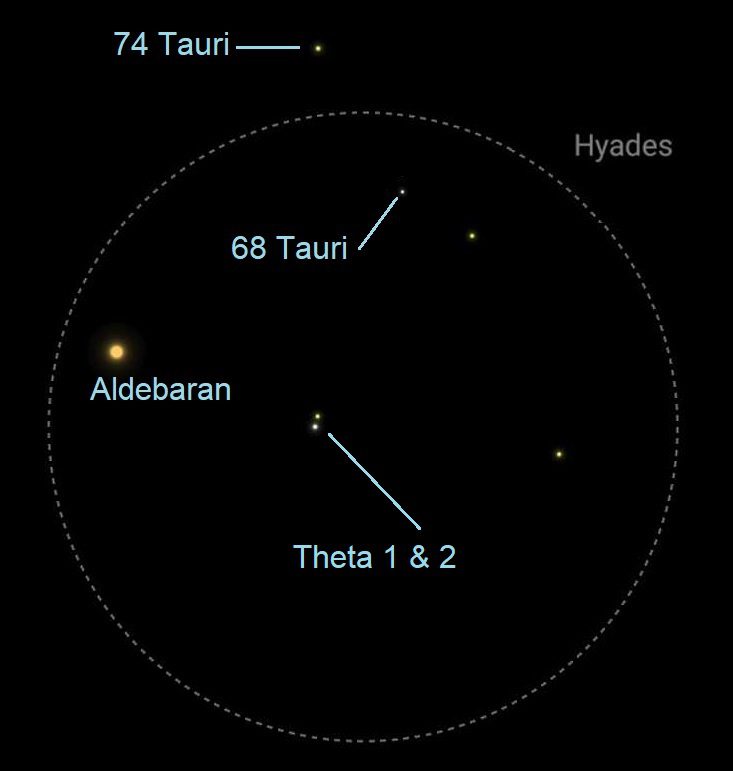
I can see to about 4.5 magnitude stars from my yard without binoculars. Six stars are visible in the Hyades, the faintest and most challenging for me is 68 Tauri (4.3 magnitude). The brightest star, Aldebaran, is not a true cluster member. It is about 65 light years from Earth, less than half the distance to the Hyades. Theta 1 and 2 Tauri are 337 arc-seconds apart and constitute a naked eye double. I can just resolve them. It takes some concentration. A seventh star, Epsilon Tauri (74 Tau), shining at 3.5 magnitude just outside the cluster boundary, completes the “V” shape. If you can see stars down to 5.0 magnitudes, 12 stars may be visible in the cluster, with a couple more hovering nearby. Twenty-seven stars (down to 6.5 magnitude) might be seen under dark skies, if you have good eyesight. Particularly sharp eyed observers under the darkest skies might be able to see stars as faint as 7.5 magnitudes.
So, let’s do some binocular astronomy. Finally. With the Oberwerk 8×32 SE, which has a field of 8.2 degrees, the Hyades looks something like this.
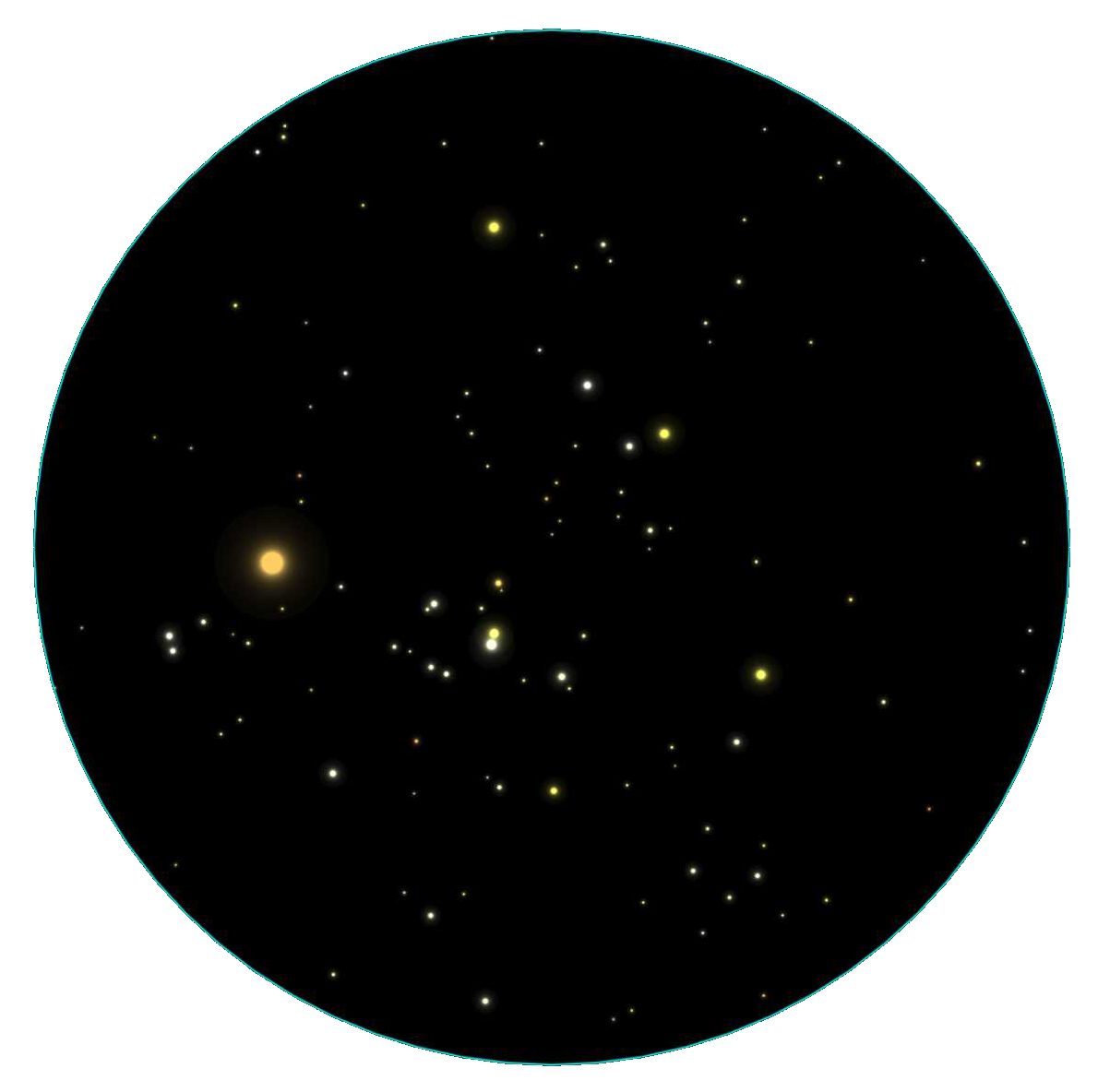
This image, simulated with the Sky Safari app, show stars to 8.2 magnitudes. That is not an arbitrary choice. By carefully studying the field, on a reasonably good night from my yard, I was able to see stars to 8.2 magnitude with the 8×32 SE hand held. This is approximately the view I had. (The star symbol size is exaggerated for brighter stars – in the actual view the brighter stars are pinpoints, not swollen balls.) But think about this for a minute. The dimmest stars that can be seen naked eye, by those with particularly acute vision, from the darkest sites anywhere, are 7.5 magnitude. From my suburban yard, in light polluted skies (Bortle 7 / mpsas 18.0 measured with an SQM-L for the technically inclined), wearing glasses to correct myopia and astigmatism, with an 8×32 binocular, significantly fainter stars can be seen.
I am often meet with surprise from astronomy friends when I say that 90% of my observing is done from my suburban yard. It’s not that dark sky sites aren’t wonderful, but I can’t regularly fit 1 to 2 hour drive times, set up, and everything else that goes into observing form a remote location into my schedule. Any clear night, I can step outside for a few minutes and do some astronomy. (And most clear nights, what I told myself would be a few minutes often turns into an hour or more.) I think people look at a light polluted, bright, lackluster sky and ask themselves what’s the use? I won’t be able to see anything. When the truth is, a lot can be seen.
Here is how the Pleiades looks in the same binocular.
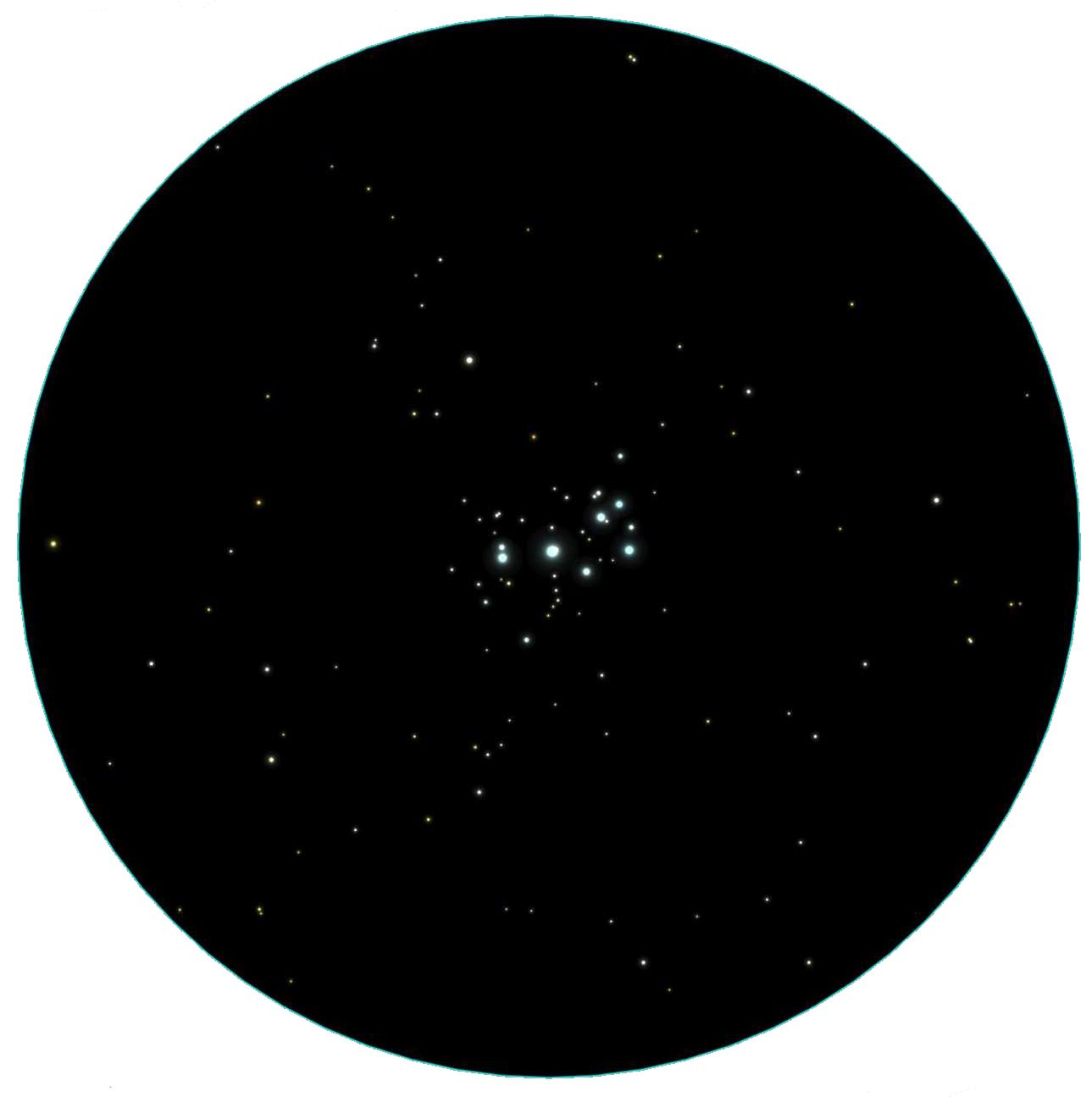
Notice how much smaller it looks in the field of view? That is 110 arc-minutes versus the 330 arc-minutes of the Hyades. Also note how compact it is and how the prominent stars are bright bluish white. These are young hot stars that have a short stellar lifetime because the Pleiades is a much younger cluster. Look back at the Hyades and note how the stars are more spread out and have a greater variety of color – many of them are much older, and much cooler and there is much more diversity in the stellar types because many of the young, hot blue white stars are gone.
If you look closely near the top of the field you will see two light yellow stars nestled together. This is a double star listed in the Washington Double Star catalog maintained by the US Naval Observatory. The identifier for the double star is STTA 38. Here is basic information about it in the standard format used on this blog:
STTA 38
03h44m +27*54′
6.78/6.91 135.4″ pa 53*
The second line indicates the position in the sky. The first number is Right Ascension (in hours and minutes) and the second number is Declination in degrees and minutes. The third line lists the magnitudes of the primary and secondary components, their separation in arc-seconds, and the position angle of the secondary component in relationship to the primary. (Let’s not worry too much about that last bit for now.) The main point here is that these stars are bright and widely separated so the double star can be resolved with handheld binoculars like the 8×32 SE. Resolved means that both components can be seen as distinct stars. Can you spot STTA 38 with your binoculars? According to the information in Sky Safari, it is 186 light years away.
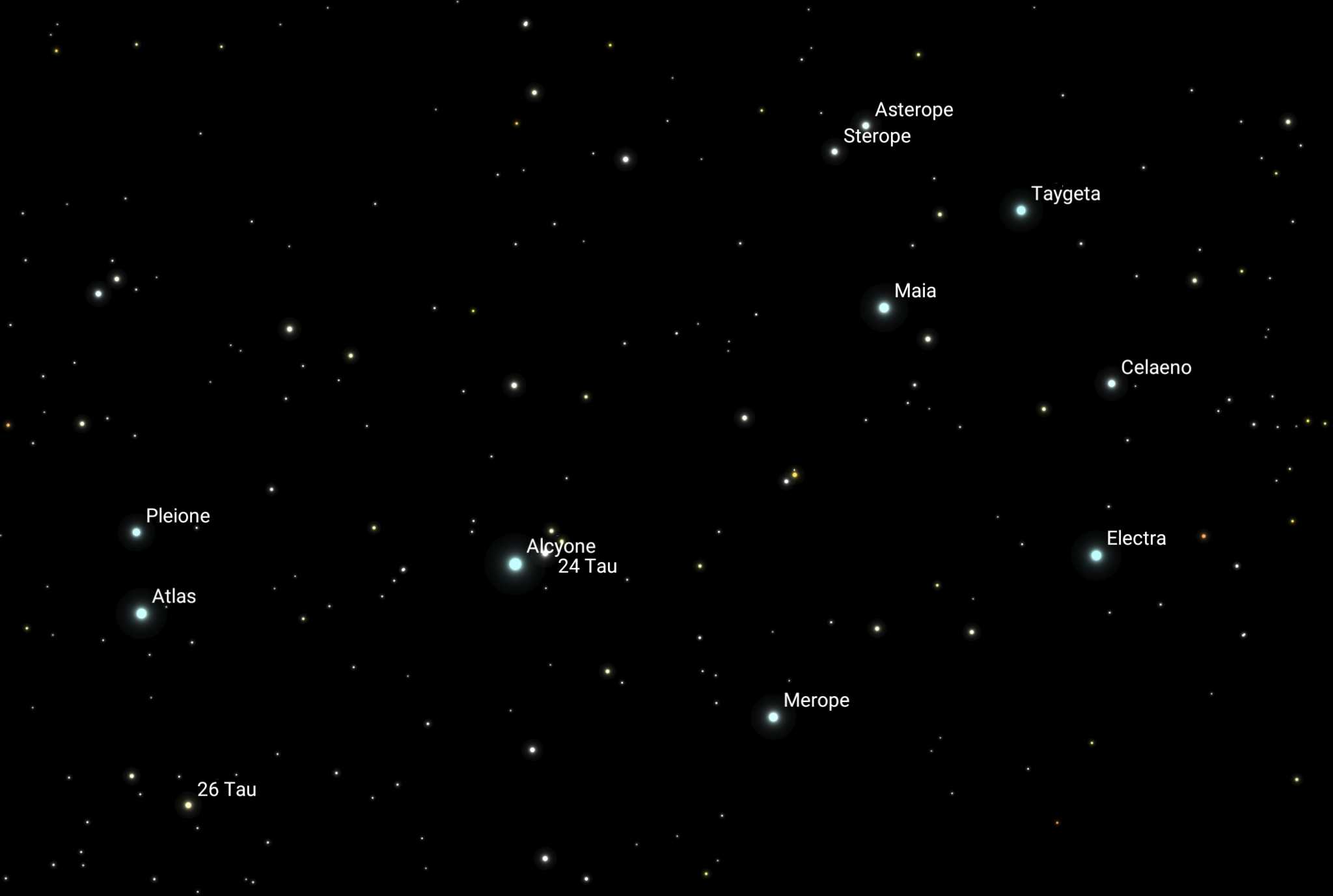
Although I have enjoyed countless views of the Pleiades over the years, it only recently occurred to me to pick out the stars by name as I was viewing the cluster. And several intriguing truths immediately present themselves. First, one of the 5-6 stars commonly seen naked eye is not one of the seven sisters, but actually Atlas, their father. (Pleione is their mother.) Another interesting detail is that if you count the sisters named in the map above, you will find eight, not seven, names. Asterope seems to be an alternative spelling of the name Sterope. In Sky Safari the two names are assigned to 21 and 22 Tauri, a wide double star. However, according to Richard Hinkley Allen’s Star Names: Their Lore and Meaning, Sterope I and Sterope II are more correct. Hmmm. The double star name is HJL 1026 with magnitudes of 5.75 and 6.42 and a separation of 149.6 arc-seconds. It is said to be a physical double star. (HJL is the discoverer code for Jean-Louis Halbwachs.)
Here is how Collinder 65 looks with the OB 8×32 SE.
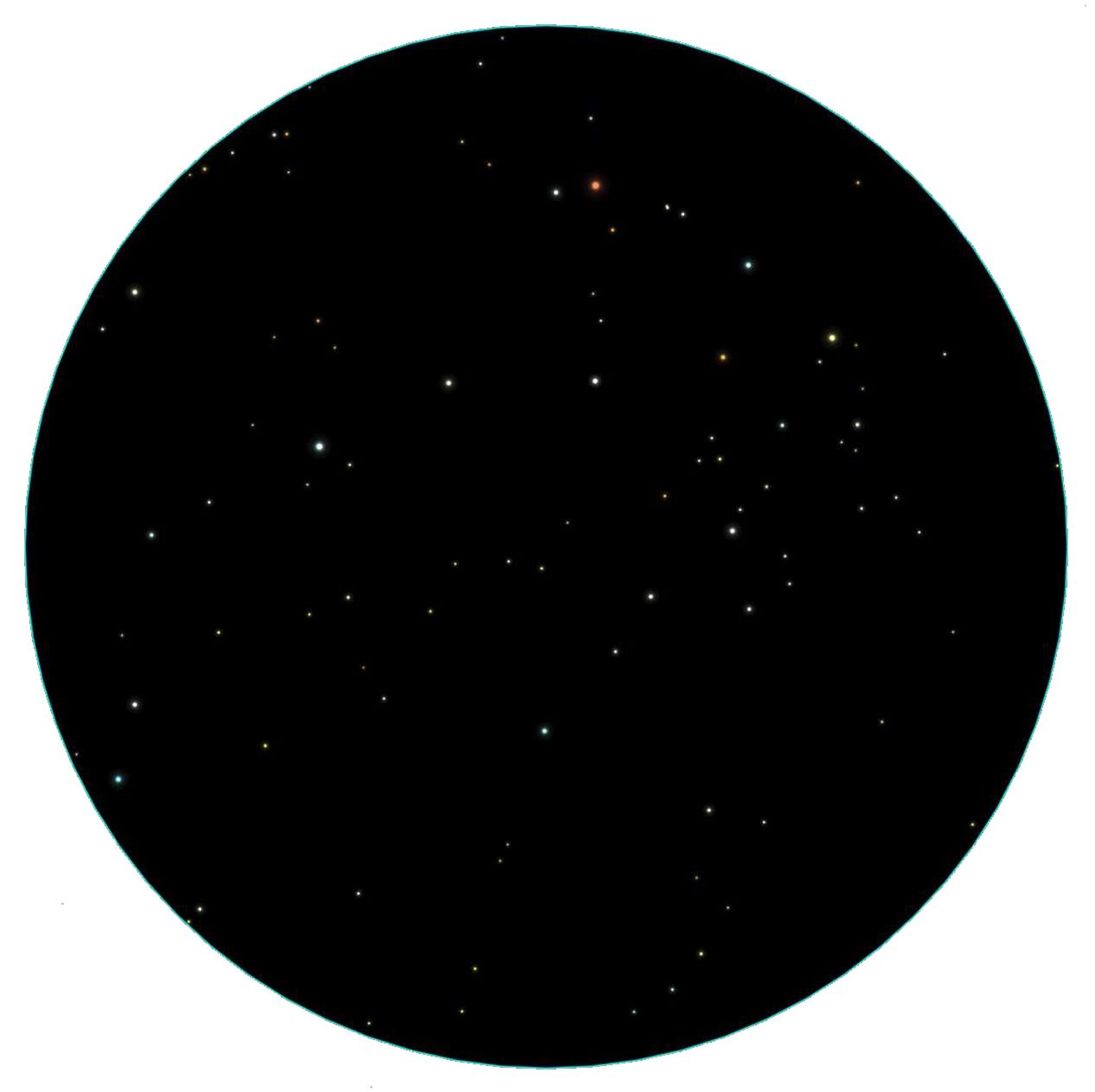
Similar to the Hyades, Collinder 65 is looser and more spread out than the Pleiades, with a mix of warmer colored stars, although the most obvious orange colored star in the field, 119 Tauri, a red super-giant, is around 1800 light years distant, much more distant than the cluster itself and thus not a true member. Although I have not been able find an age estimate for Collinder 65, it is likely to be significantly older than the Pleiades, and possibly the Hyades as well. Collinder is by far the largest of the three, appearing smaller than the Hyades only because it is so much farther away. With binoculars it is readily identified as an arrow with a curving shaft that extends into an oddly shaped nook of the IAU constellation boundary for Taurus.
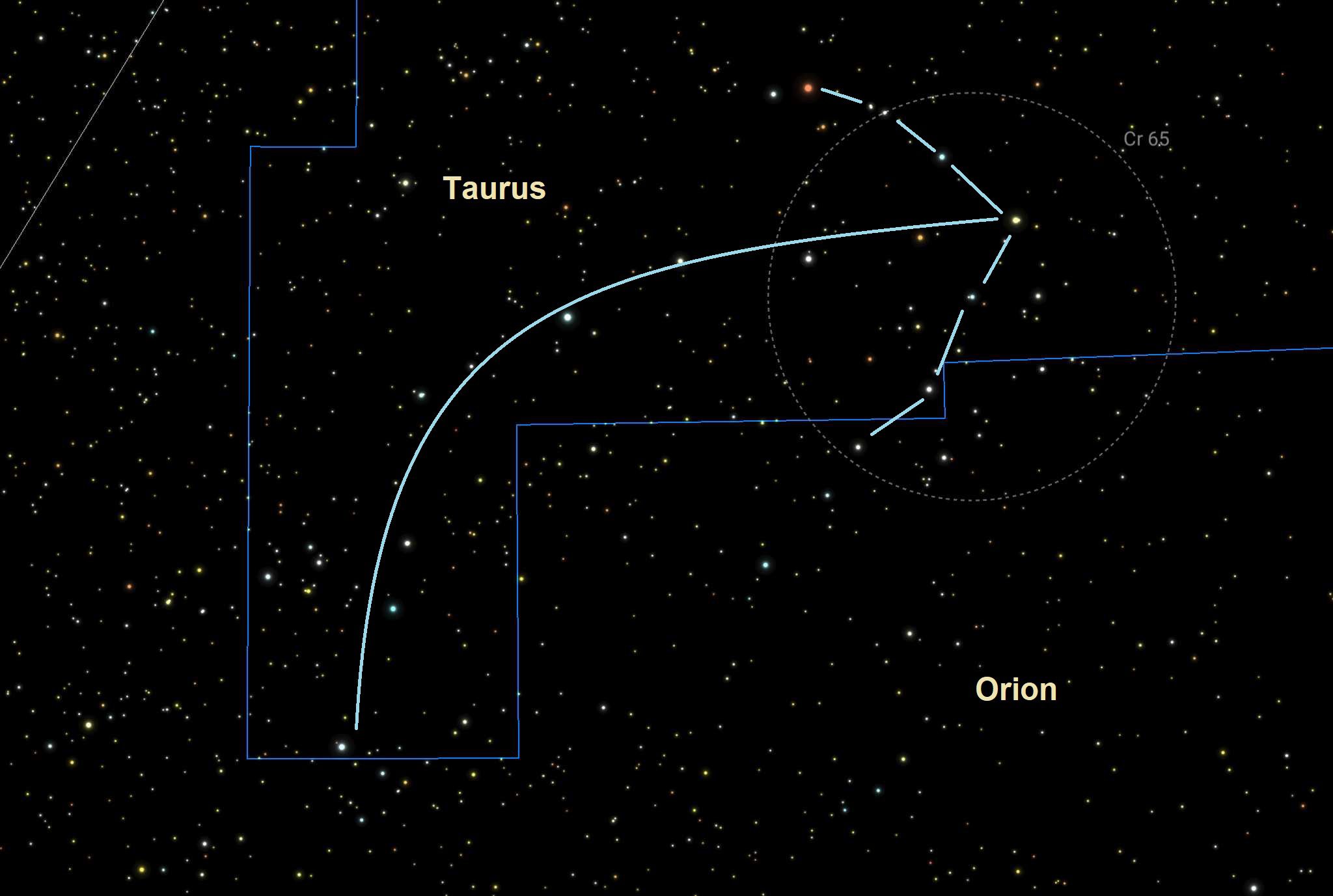
Let’s close out this tour with a fun treat — a humorous asterism created by the late amateur astronomer, John Davis. An “asterism” is a pattern of stars. Many constellations are known by their primary bright asterism, the constellation itself often being much larger and more complex. The Big Dipper is the well-known asterism of the constellation Ursa Major, which is far larger than the dipper itself and in its entirety forms the shape of a bear. But asterisms don’t have to be large and bright, they can be small binocular objects. No official directory of these exists, but various lists circulate, and the more popular/successful asterisms catch on and develop a following. The Astronomical League offers an observing program for binocular asterisms with a list of over 100. Davis’s Dog, near the Hyades, is one of the best. It is comical to see, wagging its tail waiting for you.
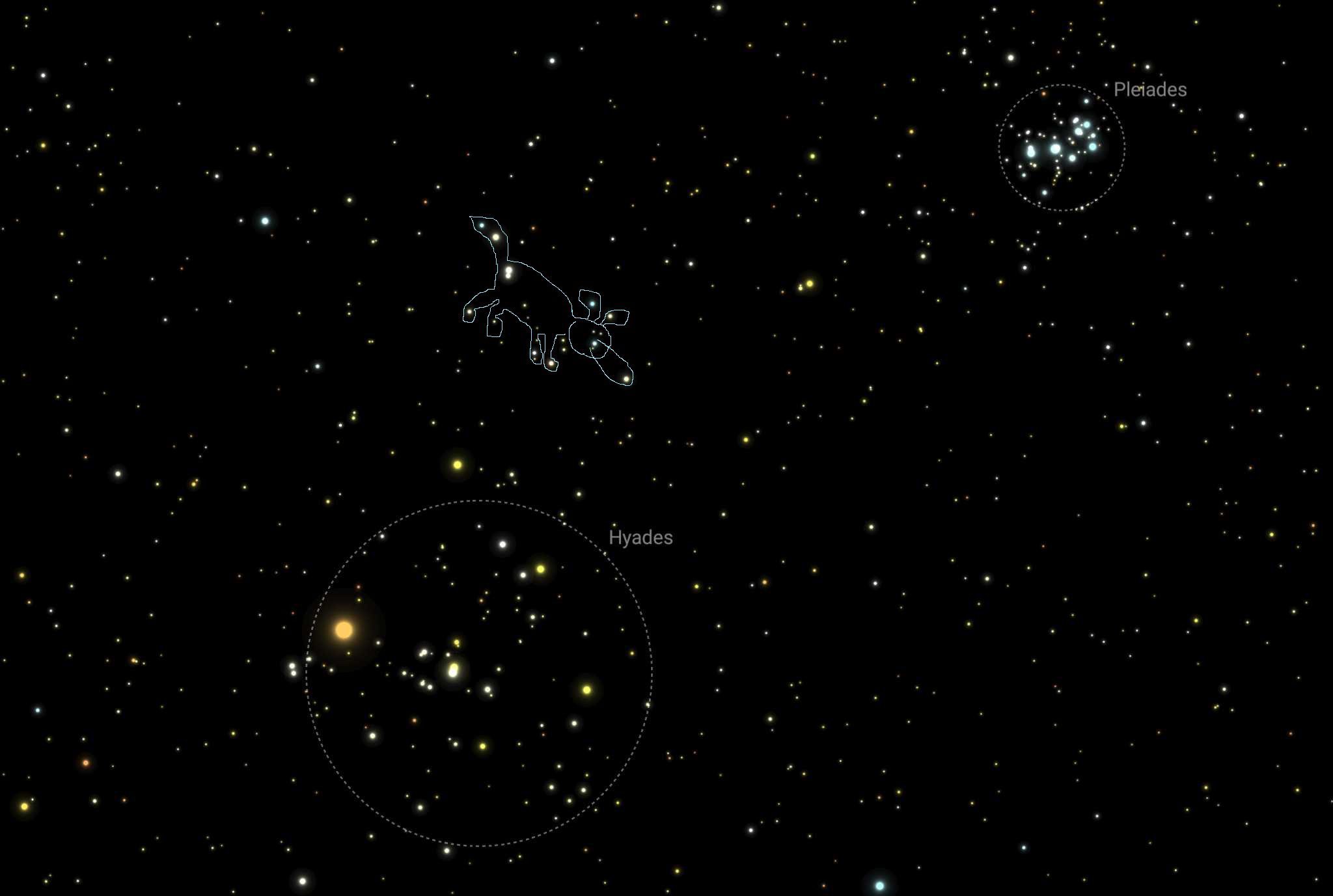


Enjoyed your commentary, Fiske! The Pleiades and Hyades are long time favorites of mine, visually and binocular. You inspire me to take a tour of them, Collinder 65 and Davis’s Dog.
Thanks for visiting, Harry. Have fun on your next trip to Taurus. 🙂
Thx for sharing, I enjoyed alot. Looking forward for more.
Cheers from (cloudy)Poland.
Thank you, Andrzej!
I recently had my first binocular astronomy session with a pair of inexpensive 8x42s.
The Pleiades and Hyades were two of my main targets. I knew a little bit about the Pleiades before but love all the info here and really puts things into perspective for me (adds to my sense of awe).
I look forward to searching for Collinder 65 next time and following along with the blog for future targets!
Thanks for checking in, Will. And congratulations on your first binocular astronomy observing session. You’ve made a great start.
Just got back inside from spending about an hour in Taurus & surrounding areas. I was mainly using my new 6.5x32LW and also a 15×70 SkyMaster on p-mount. I wanted to see if these small glasses could make out our latest visiting comet, and figured I’d give these clusters a go while there. There was basically zero cloud cover, with 4/5 transparency & 2/5 seeing, and the last quarter moon was still well below the horizon.
All 3 clusters were absolutely beautiful and their colors were more vivid than I’d imagine a little bino could pull out.
Theta 1 & 2 Tauri showed a light blue and pale yellow with Aldebaran glowing a bright orange, while E3(ZTF) was a defuse smudge with a evident elongation in the tails direction stretching up towards NGC1647, all in the same 8° FOV. The 15×70 revealed the comet’s wide tail and showed some detail with adverted vision and while using a sweeping movement with the binos.
The Pleiades was a stunning compact site with its main components shinning a bright electric blue and fainter stars of a similar color sprinkled about giving a feeling of depth to the cluster.
Collinder 65 surprised me with it’s size and the variation of star colors within it. The asterism reminded me of a giant mushroom leaning over, with the stem leading down to the angry blazing ember Betelgeuse.
I spent some time in Orion having my mind blown with just how capable these cheap 6.5×32 binos could be… but that’s a little off topic for this post 😏 I will say that these LWs are the perfect companions to keep with your star charts!!
Anyway, I really enjoyed my tour through these super-sized clusters in Taurus!! I hope others are able to give them a go in a small pair of binos and have as much fun doing it as I just did!!
Thanks Fiske & clear skies,
– AstroApe
Excellent observing report, Astro. Thank you for sharing it! 😊
And I agree that Collinder 65 looks like a giant mushroom leaning over. 😉 (It also includes a bat asterism that will be the subject of an upcoming post.)